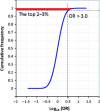Prostate cancer genomics, biology, and risk assessment through genome-wide association studies
- PMID: 22181854
- PMCID: PMC7659324
- DOI: 10.1111/j.1349-7006.2011.02193.x
Prostate cancer genomics, biology, and risk assessment through genome-wide association studies
Abstract
Prostate cancer (PC) is the most common malignancy observed in men. It is evident that genetic factors play some important roles in PC etiology. Recently, genome-wide association studies in diverse ethnic groups have identified more than 40 germline variants of various genes or chromosomal loci that are significantly associated with PC susceptibility, including multiple 8q24 loci, prostate-specific genes, metabolic and hormone-related genes, and many regions where no coding gene is annotated. However, there are only a few variants or genes for which biological significance or functions have been elucidated so far. The greatest challenge related to genome-wide association studies loci in prostate genomics is to understand the functional consequences of these PC-associated loci and their involvement in PC biology and carcinogenesis. There have been attempts to determine PC risk estimations by combining multiple PC-associated variants for clinical tests, and these can identify a very minor population with high risk of PC. However, they cannot distinguish risk of aggressive PC from that of non-aggressive PC. Further identification of PC-susceptibility loci in larger genome-wide association studies cohorts and biological insights gained from such functional analyses have the potential to translate into clinical benefits, including the development of reliable biomarkers, risk estimation, and effective strategies for screening and prevention of PC.
© 2011 Japanese Cancer Association.
Figures



Similar articles
-
Prostate cancer genomics by high-throughput technologies: genome-wide association study and sequencing analysis.Endocr Relat Cancer. 2013 Jun 24;20(4):R171-81. doi: 10.1530/ERC-13-0113. Print 2013 Aug. Endocr Relat Cancer. 2013. PMID: 23625613 Review.
-
[Genome-wide association study(GWAS) and genetic risk of prostate cancer].Nihon Rinsho. 2016 Jan;74(1):34-9. Nihon Rinsho. 2016. PMID: 26793876 Japanese.
-
Association of a novel long non-coding RNA in 8q24 with prostate cancer susceptibility.Cancer Sci. 2011 Jan;102(1):245-52. doi: 10.1111/j.1349-7006.2010.01737.x. Epub 2010 Sep 28. Cancer Sci. 2011. PMID: 20874843
-
Modifier locus mapping of a transgenic F2 mouse population identifies CCDC115 as a novel aggressive prostate cancer modifier gene in humans.BMC Genomics. 2018 Jun 11;19(1):450. doi: 10.1186/s12864-018-4827-2. BMC Genomics. 2018. PMID: 29890952 Free PMC article.
-
Screening for familial and hereditary prostate cancer.Int J Cancer. 2016 Jun 1;138(11):2579-91. doi: 10.1002/ijc.29949. Epub 2016 Feb 5. Int J Cancer. 2016. PMID: 26638190 Review.
Cited by
-
TWIST2: A new candidate tumor suppressor in prostate cancer.Prostate. 2019 Oct;79(14):1647-1657. doi: 10.1002/pros.23889. Epub 2019 Aug 21. Prostate. 2019. PMID: 31433071 Free PMC article.
-
Upregulation of FAM84B during prostate cancer progression.Oncotarget. 2017 Mar 21;8(12):19218-19235. doi: 10.18632/oncotarget.15168. Oncotarget. 2017. PMID: 28186973 Free PMC article.
-
In Silico Analysis of Post-COVID-19 Condition (PCC) Associated SNP rs9367106 Predicts the Molecular Basis of Abnormalities in the Lungs and Brain Functions.Int J Mol Sci. 2025 Jul 11;26(14):6680. doi: 10.3390/ijms26146680. Int J Mol Sci. 2025. PMID: 40724930 Free PMC article.
-
Skewed X-chromosome inactivation in patients with esophageal carcinoma.Diagn Pathol. 2013 Apr 4;8:55. doi: 10.1186/1746-1596-8-55. Diagn Pathol. 2013. PMID: 23556484 Free PMC article.
-
Single nucleotide polymorphisms in DKK3 gene are associated with prostate cancer risk and progression.Int Braz J Urol. 2015 Sep-Oct;41(5):869-97. doi: 10.1590/S1677-5538.IBJU.2014.0041. Int Braz J Urol. 2015. PMID: 26689513 Free PMC article.
References
-
- Gronberg H. Prostate cancer epidemiology. Lancet 2003; 361: 859–64. - PubMed
-
- Hsing AW, Devesa SS. Trends and patterns of prostate cancer: what do they suggest? Epidemiol Rev 2001; 23: 3–13. - PubMed
-
- Schaid DJ. The complex genetic epidemiology of prostate cancer. Hum Mol Genet 2004; 13: R103–21. - PubMed
-
- Lichtenstein P, Holm N, Verkasalo P et al Environmental and heritable factors in the causation of cancer – analyses of cohorts of twins from Sweden, Denmark, and Finland. N Engl J Med 2001; 343: 78–85. - PubMed
-
- Matsuda T, Saika K. Comparison of time trends in prostate cancer incidence (1973–2002) in Asia, from cancer incidence in five continents, Vols IV–IX. Jpn J Clin Oncol 2009; 39: 468–9. - PubMed
Publication types
MeSH terms
Substances
LinkOut - more resources
Full Text Sources
Other Literature Sources
Medical

